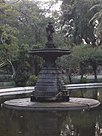Rio Grande | |
|---|---|
| Municipality of Rio Grande | |
| Nickname: Noiva do mar (Bride of the Sea) | |
 | |
| Coordinates: 32°02′06″S 52°05′55″W / 32.03500°S 52.09861°W | |
| Country | |
| Region | South |
| State | |
| Founded | 1737 |
| Incorporated | 1835 |
| Government | |
| • Mayor | Fábio Branco (MDB) |
| Area | |
• Total | 2,709.53 km2 (1,046.16 sq mi) |
| Elevation | 6 m (20 ft) |
| Population (2022[1]) | |
• Total | 191,900 |
| • Density | 71/km2 (180/sq mi) |
| Time zone | UTC−3 (BRT) |
| Postal code | 96500 |
| Area code | (+55) 53 |
| HDI (2010) | 0.744 – high[2] |
| Website | www |
Rio Grande (lit. "Great River") is a municipality (município) and one of the oldest cities in the Brazilian state of Rio Grande do Sul. It was the state capital from 1835 to 1845. It is the most important port city in the state and has one of the most important maritime ports in Brazil.
The city is named after a nearby channel which indirectly connects the Lagoa dos Patos, to the northeast, and Lagoa Mirim, to the west, with the Atlantic Ocean. The municipality is bordered by Santa Vitória do Palmar on the south and Pelotas on the north, which lies across the São Gonçalo Channel.
The city built up its wealth over the course of its long history of strong industrial movements. Today it is still one of the richest cities in Rio Grande do Sul, mainly because of its port, the second busiest in Brazil, and its refinery, which processes Ipiranga petroleum.
The city is served by Rio Grande Airport.
- ^ IBGE 2022
- ^ "Archived copy" (PDF). United Nations Development Programme (UNDP). Archived from the original (PDF) on July 8, 2014. Retrieved August 1, 2013.
{{cite web}}: CS1 maint: archived copy as title (link)








